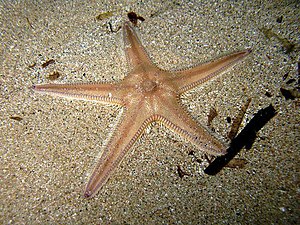Nordic comb star
| Nordic comb star | ||||||||||||
|---|---|---|---|---|---|---|---|---|---|---|---|---|

Astropecten irregularis , Sardinia |
||||||||||||
| Systematics | ||||||||||||
|
||||||||||||
| Scientific name | ||||||||||||
| Astropecten irregularis | ||||||||||||
| ( Pennant , 1777) |
The Nordic comb star ( Astropecten irregularis ) is a type of comb star from the order of the Paxillensterne (Paxillosida), which is common on sedimentary soils from 10 m depth from the Mediterranean to the western Baltic Sea.
features
The Nordic Kammstern has the regular, flattened shape typical of Kammsterne with five triangular arms adjoining each other at clear angles and reaches a diameter of 10 cm to 12 cm, maximum 19 cm. The color of its upper side varies from light orange to beige to red, often merging into purple towards the tips of the arms and sometimes with small, darker spots in the middle.
In contrast to other crest stars of the Mediterranean Sea, the Nordic crest stars there have superomarginal plates (upper edge plates) without thorns and coloring, but the superomarginal plates in the populations of the Atlantic each have a thorn. According to this characteristic, the two subspecies Astropecten irregularis pentacanthus (Mediterranean) and Astropecten irregularis irregularis (Atlantic) are distinguished. The inferomarginal plates are short, thin, finely thorny, white in color and very mobile. In contrast to other comb stars, these thorns in Astropecten irregularis do not remain stiff and parallel to one another, but are flexible. In the middle on the side facing away from the mouth there is a hump which the buried animal lets protrude from the sediment and which is used for breathing.
The Nordic comb star covers distances of 1 m in a few minutes, making it faster than most starfish.
Reproduction
The Nordic starfish reproduces exclusively sexually. Like most starfish, it is segregated. Males and females do not differ externally and appear in roughly equal numbers. The eggs are fertilized externally and develop into free-swimming larvae .
Occurrence
The Nordic Kammstern occurs in the Mediterranean , Atlantic , North Sea and western Baltic Sea at depths of about 10 m to 1000 m. It is common on the sandy and muddy soils there.
Lifestyle and diet
Astropecten irregularis usually remains buried in the sediment during the day. In the late afternoon and night, the starfish become active and hunt for prey. Astropecten irregularis mainly eats small mussels and snails , but also sea urchins , brittle stars and carrion . The prey is swallowed whole, often in large numbers, so that the center of the body arches up, and digested in the stomach. Indigestible residues such as mussel shells are released back out through the mouth opening.
literature
- Sven Gehrmann: The fauna of the North Sea - lower animals & vertebrates . Epubli, Berlin 2011. p. 152.
- Georgina Jones: A field guide to the marine animals of the Cape Peninsula . SURG, Cape Town 2008. ISBN 978-0-620-41639-9
- Réné Koehler (1921): Faune de France. Echinodermes .
- Enrico Tortonese (1965): Fauna d'Italia. Echinodermata .
- Roberto Pillon (2009): Astropecten of the Mediterranean Sea .
Web links
- Underwater World Baltic Sea: Nordischer Kammstern, Astropecten irregularis (Pennant, 1777)
- DORIS
- WoRMS
- SeaLifeBase
- Naturamediterraneo
- Marlin
- Encyclopedia of Marine Life of Britain and Ireland
- The Marine Flora & Fauna of Norway
- Mer et littoral
